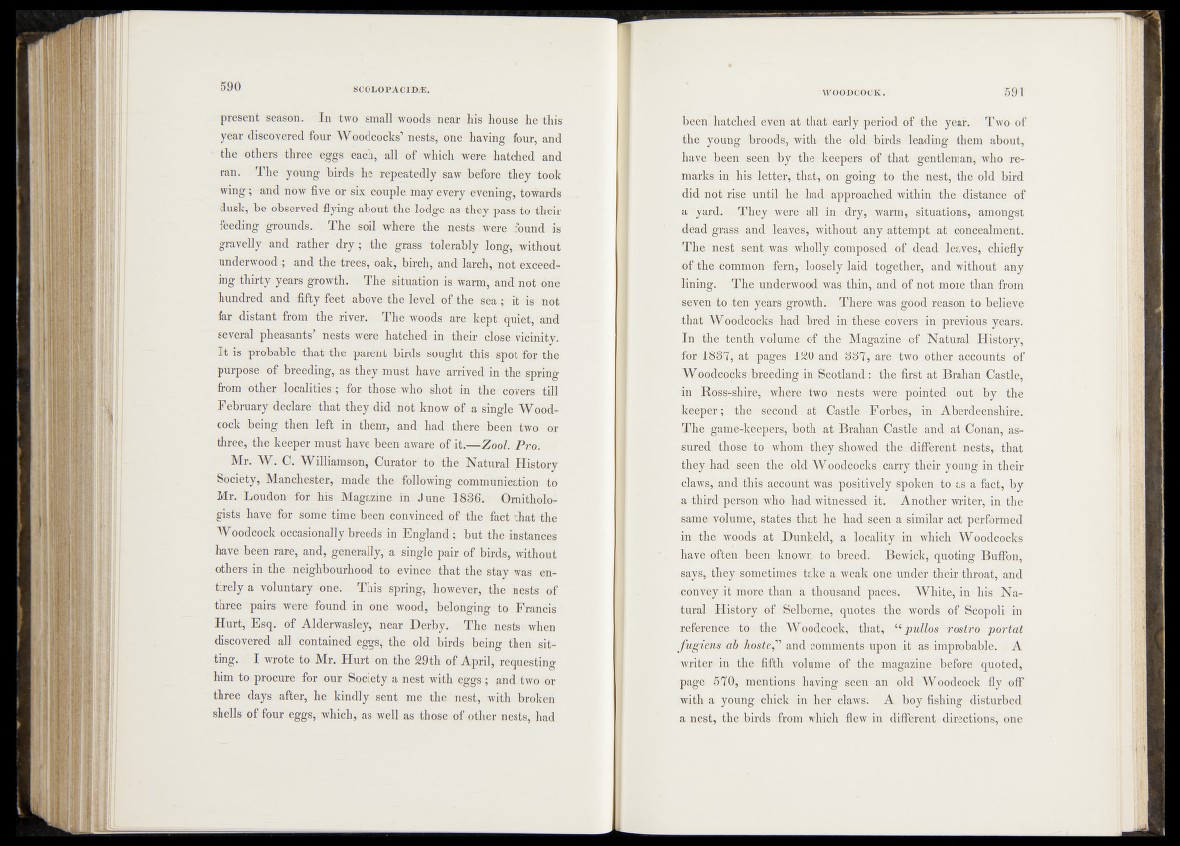
present season. In two small woods near his house he this
year discovered four Woodcocks’ nests, one having- four, and
the others three eggs each, all of which were hatched and
ran. The young birds he repeatedly saw before they took
wing ; and now five d r six couple, may every evening, towards
dusk, be observed flying about the lodge as they .pass to their
feeding grounds. The soil where the nests vwere found is
gravelly and rather d ry ; . the grass tolerably long, without
underwood ; and the trees, oak, birch, and larch;-pot exceeds
ihg thirty years growth. The situation is warm, and not brie
hundred and fifty feet above the level of the sea ; it is not
far distant from the river. The woods' are kept quiet,.and
several pheasants’ nesto were hatched in their ' close Vicinity.
I t is probable that the parent birds sought this spot for the
purpose of breeding, as they must have arrived in the Spring
from other localities ; for those who shot in the covers till
February declare that they did not know of a single Wood-.,
cock being then left in them, and h ad . there been two or
three, the keeper must have been aware of it.—Zoo/, Pro.
Mr. W e®. Williamson, Curator to the Natural History
Society, Manchester, made the following communleation to
Mr. Loudon for his Magazine in June 1836. Ornithologists
have for some time been convinced of the fact that the
Woodcock occasionally breeds in England ; but the instances
have been rare, and, generally, a single pair of birds, without
others in the neighbourhood to evince that the stay was entirely
a voluntary one. This spring, however, the nests of
three pairs were-, found in one wood, belonging to Francis
Hurt, Esq. of Alderwasley, near Derby. The nests when
discovered all contained eggs, the old birds being then sitting.
I wrote to-Mr. Hurt on the 29th of April, requesting
him to procure for our Society a nest with eggs ; .and two or
three days after, he kindly sent me the nest, with broken
shells of four eggs, which, as well as those of other nests, had
hatched even at that, early period of the year. ' Two of
the youog:dn?o®ids, 'with1 the bid birds leading them about,
hdve'-been -»seen -by. the- keepers of that gentleman, who re^-
maxks^in hi#dbt#ei^hat‘,r ?©n going to the nest, the-old bird
did. not rise until he had - approached within the distance of
a SpBffls- TheybMre^all inv;dry,n warm,’- situations,^amongst
dead grass and deaves^withosit any attempt at concealment.
The nest seAtjwas - whfolly*Qmpbs'fed -of dead Ida tbs', chiefly
of the .common ferm^loosidl^ilaid together;/ anfd without- any
lining? Theaanderwoiodwas thin, and of ffet more than-from
severtffr©«ten?1 years .growth. Where£ifeSjVgopd reason: to?believe
that .Whode^diks “had bred inHh®fefc^»ersrin^previ.ous years.
InytkbVfeMh/vbl um e-.-ofi th#ttMagazme.‘ ^ofi/lfetural History;.
fdrjlj§|!,7, at' ,pl^ds^l#%'and are l#i^^h@I*6* oW S ; #
Wbodcbcks'ibreedipg ruLScotland: the first at Brahan^Castftj
in Ross/sfiiffef rwheie two mei^feyelltpoin>ted} mkfef by the
keeper';" the ati/Castl'e1 Forbes,1 in- Aberdeenshire.
$®he gamefkffepbrs^both a t Brahan Castle,-?a«di4aL Conan, as/
sured ‘ thoseiSib" -whom*«they!?shio>wed fhexdiffergnt nests, that
they had’ ssen|MM&bld Woodcocks! carry th^ir young' m their
claws,' and;tMsaccbuht was positively»spokenitbiaspa fact, by
a thikdpersoniwho had Witnessed; it’. - Another writer,..in, the
same^flume, states that he had-seen a similar act performed
in the woods at Dunkeld, a locality in which Woodcocks
have often been known to-.breeds Bewick,-quoting BufFon,
-says, theyrsometimes take a weak onefmndef'thek-'throat, and
convey-it more than a thousand paces:. White, in his Natural
History of. Selborne, rqhotesif;.the words of Seopoli in
reference to the Wbodcock, that, el pullos• rostro portat
fugiem ub hoshy. and comments upon it as improbable. .A
writer-in the fifth volume of the magazine before quoted,
■page 570, mentions h a v i i |$ S 's e e n W o o d c o c k fiy off
with a young chick in her claws. A :b®y fishing disturbed
a nest, the birds from , which flew in different directions, one